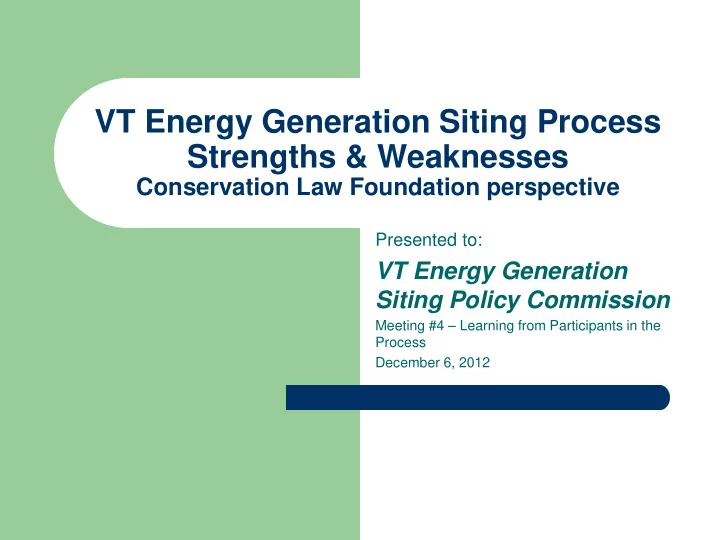

VT Energy Generation Siting Process Strengths & Weaknesses Conservation Law Foundation perspective Presented to: VT Energy Generation Siting Policy Commission Meeting #4 – Learning from Participants in the Process December 6, 2012
Background Regional environmental advocacy organization CLF protects New England’s environment for the benefit of all people. We use the law, science and the market to create solutions that preserve our natural resources, build healthy communities, and sustain a vibrant economy. Participation in numerous Public Service Board proceedings over 20 plus years Executive Committee overseeing Cow Power
Siting Models Image courtesy of Bobcatnorth@flickr.com Image courtesy of jfravel@flickr.com
Principles Better Balance of the Benefits and Burdens 1. of Generation Siting Need for Meaningful Public Engagement 2.
Siting Approval Practices #1 Strengths Board is independent, separately funded, professional, and experienced with legal – and utility matters Forum amenable to bringing a range of issues into one proceeding for permitting – Broad intervention allowed – Weaknesses No process for broader siting issues. Deals with one permit or project at a time. – Time consuming and expensive – Difficult to deal with projects changing during process – Difficult and expensive for citizen participation – Recommendations Clear time frame similar to rate cases for PSB process – Standards for changes during process – Process to address broader siting issues – More user-friendly process for citizen participation –
Siting Approval Practices #2 Strengths: – Same substantive criteria as Act 250 – Incorporates standards from other permits – Broad appeal rights – Decisions based on evidence presented during technical hearings Weaknesses: Permitting occurs before some impacts are known or understood. – Project burdens and benefits not balanced or addressed – Recommendations: Provide greater clarity on legal and practical effect of guidelines – Standards and guidelines should build on previous cases and maintain – high standards of protection Keep broad appeal rights –
Public Participation/Representation mechanism Strengths Broad intervention allowed – Public hearings – Mitigation / Impact fees allowed – Mechanisms available for alternative dispute resolution – Mechanism available for intervenor funding – Weaknesses Difficult and expensive for public to participate in technical hearings – Limited use of input from public hearings – Lack of clarity about how input is considered or used. – Citizens can feel ignored. – Recommendations Time-limited less formal process before 248 with independent moderator and access to technical information – that feeds into 248 process. Can include joint fact-finding Funding for independent technical expertise to assist intervenor participants – Pre-248 Scoping meetings (like FERC) that identify issues and studies and can incorporate joint selection of – experts Broader use of intervenor funding, especially for issues not being addressed by other parties –
Adequate protection of lands, environmental & cultural resources Strengths PSB process functions as umbrella and includes other permits and – standards Includes wide range of impacts and issues – Broad authority and use of conditions and mitigation to address impacts – Weaknesses Timing and coordination not well synchronized – Difficult to address project changes that happen along the way – Perception that standards are different or applied differently compared to – other projects Recommendations Establish timing and coordination at outset – Expand and clarify how offsets, mitigation, and conditions to address – environmental impacts provide needed protection of resources Be open to “out of the box” solutions to protect public benefits –
Monitoring Compliance Strengths – Room to develop an effective system – Prompt and professional resolution Weaknesses – System not set up for monitoring – Farm methane projects; Board oversight of farming operations Recommendations – Separate farming operations from Board oversight of electricity generation, similar to how landfill electricity generation is treated.
Summary of Strengths & Weaknesses: Recommendations Strengths – Professional, inclusive, independent, evidence based decision-making Weaknesses – Lack of effective public engagement Changes / Key Recommendations – Process for broader siting decisions – Improve access to independent technical expertise for those participating – Preliminary scoping process and joint fact finding.
More Information Sandra Levine Conservation Law Foundation Montpelier, VT slevine@clf.org 802-223-5992
Recommend
More recommend